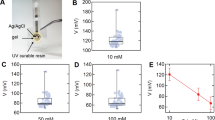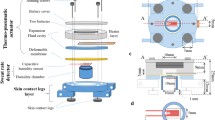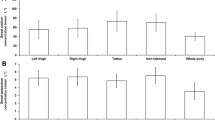Abstract
In modern industry, workers in factories are mostly engaged in maintenance, welding, assembling and other physical activities with higher metabolic rate than office works. The evaluation of thermal environment with such physical activity is important for the welfare of workers and enhancing their working efficiency. With the increase of physical activity, the metabolism and heat production of human body will increase, which is often accompanied by sweat regulation. The amount of sweat is an important factor in calculating the evaporative heat loss of the human body, as well as an important component of the thermal balance of human body. In this study, experiments were carried out to test people’s sweat rate using sweat absorption paper. All subjects were Chinese college students. The air temperatures during experiments were 26, 28 and 30 °C. Metabolic rate, mean skin temperature and ear-canal temperature were tested. Subjects took three activities of sitting and carry heavy box with two different weights. The tested mean metabolic rates for three activities were 1.18 met, 1.7 met and 2.73 met. The results show that sweat rate will increase as metabolic rate and air temperature increases. With increase of activity level, mean skin temperature showed a tendency to increase first and then decrease. This was caused by increased sweat and evaporative heat. Sweat rate model was deduced based on maximum evaporative heat and required evaporative heat. Compared to the original Shapiro prediction equation and the piecewise equation, the new model predicts sweat rate more accurately.
Access provided by Autonomous University of Puebla. Download conference paper PDF
Similar content being viewed by others
Keywords
1 Introduction
According to statistics, people spend almost 90% of time indoors. Indoor environment has a direct impact on people’s health and work efficiency [1,2,3,4]. In offices, people mainly work at lower levels of activity. With the development of mechanization and automation, the physical activities of workers are no longer heavy physical labour in modern factory workshops. However, their activity levels are still higher than that of people working in offices, most of which are in the range of 2–3 met. Considering the running cost and other issues, in most factories no air conditioning facilities are installed in summer in China. For workers who have to work in such environment in summer sweating would become a natural reaction to dissipate heat. Sweat rate is an important factor affecting body’s heat dissipation and maintaining thermal balance.
Most of the existing sweat rate predicting models are obtained from experiments based on people who are engaged in intensive sports training [5, 6]. The applicability of these models is doubted if they were applied to workers working in different activity levels. It is difficult to guarantee the accuracy of prediction.
In this study, experiments were carried out with different moderate physical activities, in which sweat rate and some of the physiological parameters were tested. A predicting model was established to predict sweat rate of Chinese people who work under low and medium activity levels.
2 Methods
Sweat rate is related to physiological parameters. The influence of these physiological parameters on sweat needs to be verified and analyzed. In this paper, experiments were carried out in three different temperature conditions (26, 28, and 30 °C). Participants were asked to perform tasks within the range of 1.0– 3.0 met. There were three kinds of activities: sitting, activity 1 and activity 2. Activity 1 and 2 were same activity of carrying heavy box. The weight of box is 4 kg for activity 1 and 8 kg for 2.
The experiments were carried out in an artificial climate chamber. The plan of the chamber used in the experiment is shown in Fig. 1.
There were 14 subjects participated in the experiments including 8 males and 6 females. The subjects were college students. In each experiment, two subjects were tested. The statistics of subjects are shown in Table 1. During the experiment, subjects were required to arrive at the laboratory 30 min before the experiment, and make preparation for the experiment in advance. All the participants were healthy and were asked to eat and sleep normally before the experiment. They were asked to take shower the day before the experiment to make the body clean and keep the skin dry. The subjects wore uniform clothes for sports suits, sports shoes, and socks. The thermal resistance of clothes is about 0.5 clo [7, 8].
The environmental parameters tested in the experiment were air temperature, relative humidity, radiant temperature, and air velocity. In the experiment, testo174H temperature and humidity recorder were used to monitor the environment temperature and humidity; JTR04 black bulb thermometers were used to record indoor climatic radiation temperature; Kanomax600 handhold digital anemometer was used to test indoor air velocity.
The physiological parameters tested were metabolic rate, skin temperature, and core temperature. The metabolic rate was measured using Vmax Encore sports cardiopulmonary function test system (SensorMedics). The skin temperature in this experiment was measured by iButtonDS1923, a button-type temperature, and humidity recorder. The skin temperature was measured using the five-point method which measures local skin temperature of forehead, chest, back, upper arm and thigh. The mean skin temperature (tsk) was calculated by the following equation [9]:
The core temperature of the body was represented by the eardrum temperature (ear-canal temperature) measured by IR1DB ear-canal thermometer (Microlife).
The sweat rate of the body was tested by the method of absorbent patches/pads, which were attached to different parts of body [10]. The pads would be weighed before and after the experiments and the added weight was caused by sweat. Sweat rate of per unit area was calculated based on weight gain and area of each pad, and total sweat rate of body was calculated based on each pad and its area weighting coefficient. The experimental flow chart is shown in Fig. 2.
3 Results and Analysis
In the analysis of experimental data, descriptive statistics, difference analysis, correlation analysis, and regression analysis were carried. SPSS 20 and Origin 9.0 data processing software was used.
The measured values of environmental parameters in the experiment are shown in Table 2.
The physiological parameters measured in the experiment were metabolism, skin temperature, ear-canal temperature and sweat rate.
In the experiment, the measured metabolism of the subjects in sitting, activity 1 and activity 2 is shown in Table 3.
The mean skin temperature in all experiments was shown in Fig. 3. From Fig. 3, mean skin temperature was increased as ambient temperature increased. The mean skin temperature tended to decrease as metabolic rate increased. This was mainly because the sweating activity. As metabolic rate increases, sweat will increase too, which leads to the increase of evaporative temperature and decrease of mean skin temperature.
The statistics of subjects’ ear-canal temperature were shown in Table 4. From Table 4, it can be seen that the ear-canal temperature remained stable in all conditions. The mean value ranged from 36.17 to 36.33 °C. When the ambient temperature increases, the ear-canal temperature dropped slightly. However, the change was not significant. To some extent, ear-canal temperature represents the change of body core temperature, which is relatively stable. Therefore, it was reasonable that the ear-canal temperature changed little.
The tested sweat rate of subjects was shown in Table 5. As expected, with the increase of both temperature and metabolism, the sweat rate increased.
The results of correlation analysis are shown in Table 6. The correlation coefficient between sweat rate and metabolic rate was 0.808, indicating a strong correlation. And the correlation coefficient between sweat rate and temperature was 0.572, which meant moderate relevant.
The relation of mean skin temperature and sweat rate was shown in Fig. 4. According to Fig. 4, when the ambient temperature increases, mean skin temperature and sweat rate increases under the same metabolic rate. When the metabolic rate increases, sweat rate increases but skin temperature decreases under the same ambient temperature. This indicated that with higher sweat rate mean skin temperature would be lower.
The relationship between ear-canal temperature and sweat rate was shown in Fig. 5. The overall variation range of ear-canal temperature was quite small. When the ambient temperature increased, the ear-canal temperature decreased slightly and the sweat rate increased under the same metabolic rate.
4 Discussion
The two commonly used sweat rate prediction models were OSE model (original Shapiro equation) and PW model (Piecewise equation).
The OSE model was based on the analysis of various environmental conditions and corresponding activity intensity in the course of American active servicemen’s marching. The sweat rate in the model was related to the required amount of evaporative heat loss \( (E_{\text{req}} ) \) and maximum latent heat loss \( (E_{{\text{max}}} ) \). It was based on the concept that the theoretical need for sweat evaporative cooling is a linear function of Ereq. And Emax, a major factor in determining the level of skin wettedness, should be a part of any sweat loss prediction formula for clothed men [11]. The OSE model is:
The OSE equation can be extended to PW equation under the conditions of low temperature and humidity:
Referred to the establishment principles of the above two models, in this paper, a new model based on experimental data can be established. \( E_{\text{req}} \) and \( E_{{\text{max}}} \) were calculated according to body heat transfer equations in ASHRAE Standard [7] and other references [11, 12] and the tested experimental conditions. The new model is:
Figure 6 compares the tested sweat rate and calculated sweat rate by Eqs. (2)–(4). The OSE prediction equation overestimated the sweat rate which had large deviation from the actual sweat rate, which meant that it could not predict the sweat rate well. The PW model was more accurate than OSE. However, some of the predictions by PW model were 50% higher than the tested sweat rate. The new predicting equation predicted the sweat rate in this experiment well with a maximum predicting error of 22%. This indicates that OSE and PW are not suitable for the prediction of sweat rate under these experimental conditions.
5 Conclusions
In this paper, experiments had been carried out to test sweat rate of Chinese college students. The results showed that sweat rate is directly affected by air temperature and metabolic rate. Increasing air temperature and metabolic rate will increase sweat rate. Metabolic rate has a greater effect on sweat rate than temperature. Mean skin temperature is also affected by ambient temperature and metabolic rate. When the ambient temperature increases, mean skin temperature increases too. When the metabolic rate increases, mean skin temperature would decrease because of increased evaporative heat loss. Ear-canal temperature changed little in all experimental conditions. Based on the experimental data, a sweat rate predicting model was suggested. This model was compared with the OSE model and PW model. The results showed that both OSE and PW model overestimated sweat rate a lot, which made them inapplicable when used in moderate activities. The model obtained in this study is more accurate in predicting sweat rate than the existing models. Considering the subjects in the experiments were young Chinese people, the applicability of the new model to different age and ethnic groups needs further study.
References
Li, L.: Study on the Mechanism and evaluation of the impact of indoor environment on personnel’s work efficiency. Doctoral Dissertation (2010)
Wyon, D.P.: The effects of indoor air quality on performance and productivity. Indoor Air 14, 92–101 (2004)
Ye, X.J., et al.: Thermal environment and productivity in factory. ASHRAE Trans. 116(1), 590–599 (2010)
Nicholls, R.: Heating, Ventilation and Air-conditioning, vol. 3. Interface Publishing, Oldham (2001)
Shapiro, Y., Pandolf, K.B., Goldman, R.F.: Predicting sweat loss response to exercise, environment and clothing. Eur. J. Appl. Physiol. 48, 83–96 (1982)
Gonzalez, R.R., et al.: Expanded prediction equations of human sweat loss and water needs. J. Appl. Physiol. 107(2), 379 (2009)
ASHRAE, 2013. ANSI/ASHRAE Standard 55: Thermal Environmental Conditions for Human Occupancy. ASHRAE, Atlanta
Chen, Y.S., Fan, J.: Clothing thermal insulation during sweating. Textile Res. J. 73, 152–157 (2003)
Nilsen, R., Nielsen, B.: Measurement of mean skin temperature of clothed persons in cool environments. Eur J. Appl. Physiol. 53, 231–236 (1984)
Verde, T., et al.: Exercise and heat-induced sweat. In: Knuttgen, H.G., et al. (eds.) Biochemistry of Exercise. Human Kinetics Publishers, Champaign (1983)
Wang, H., Songtao, H.: Analysis on body heat losses and its effect on thermal sensation of people under moderate activities. Build. Environ. 142, 180–187 (2018)
Lotens, W.A., Havenith, G.: Effects of moisture absorption in clothing on the human heat balance. Ergonomics 38, 1092–1113 (1994)
Acknowledgements
The project is supported by National Natural Science Foundation (Number 51678314).
Ethical approval All procedures performed in studies involving human participants were in accordance with the ethical standards and with the 1964 Helsinki declaration and its later amendments or comparable ethical standards. The study was approved by the University Ethics Committee and all participants were provided with written informed consent prior to the study.
Author information
Authors and Affiliations
Corresponding author
Editor information
Editors and Affiliations
Rights and permissions
Copyright information
© 2020 Springer Nature Singapore Pte Ltd.
About this paper
Cite this paper
Wang, H., Li, G., Shi, C. (2020). Predicting Sweat Rate of Chinese People under Moderate Activities Based on Experiments. In: Wang, Z., Zhu, Y., Wang, F., Wang, P., Shen, C., Liu, J. (eds) Proceedings of the 11th International Symposium on Heating, Ventilation and Air Conditioning (ISHVAC 2019). ISHVAC 2019. Environmental Science and Engineering(). Springer, Singapore. https://doi.org/10.1007/978-981-13-9520-8_6
Download citation
DOI: https://doi.org/10.1007/978-981-13-9520-8_6
Published:
Publisher Name: Springer, Singapore
Print ISBN: 978-981-13-9519-2
Online ISBN: 978-981-13-9520-8
eBook Packages: Earth and Environmental ScienceEarth and Environmental Science (R0)










